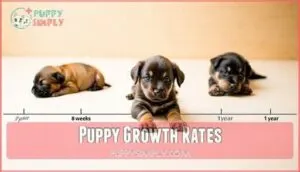This site is supported by our readers. We may earn a commission, at no cost to you, if you purchase through links.
 Your puppy’s growth journey is like watching a fast-forwarded movie – from 1 to 8 weeks, they’ll gain 5-10% of their body weight daily.
Your puppy’s growth journey is like watching a fast-forwarded movie – from 1 to 8 weeks, they’ll gain 5-10% of their body weight daily.
That’s roughly doubling their birth weight every week! After 8 weeks, growth slows but continues for 6-18 months depending on breed size.
A Golden Retriever pup might go from 1 pound to 70 pounds in their first year, while a Chihuahua reaches adult size by 6 months.
Think of it as nature’s version of a growth spurt on steroids – their little bodies are working overtime to build bones, muscles, and that adorable puppy energy we all love.
Understanding these patterns helps you anticipate those clumsy teenage months ahead, and prepare for the challenges of raising a rapidly growing puppy, experiencing a nature’s version of rapid development.
Table Of Contents
- Key Takeaways
- Puppy Growth Stages
- How Fast Puppies Grow
- Puppy Growth Rates
- Puppy Joint Development
- When Puppies Stop Growing
- Estimating Adult Size
- Growth Spurts Explained
- Frequently Asked Questions (FAQs)
- When does a puppy grow fastest?
- How long does it take a puppy to grow?
- When does a puppy develop?
- How much does a puppy grow in a day?
- How fast do dogs grow?
- How fast do small breeds grow?
- How quickly do puppies grow in a week?
- What is the 5 minute rule for puppies?
- How much bigger will my 4 month old puppy get?
- What is the hardest week with a puppy?
- Conclusion
Key Takeaways
- Your puppy’s growth is explosive early on – they’ll gain 5-10% of their body weight daily during the first 8 weeks, literally doubling their birth weight within the first week alone.
- Growth timelines vary dramatically by breed size – small breeds reach full size by 6-8 months, while giant breeds don’t finish growing until 18-24 months, so don’t expect your Great Dane to mature as quickly as your Chihuahua.
- You’ll need to protect their developing joints – growth plates don’t close until 6-18 months, depending on breed, so avoid high-impact exercise and jumping until your vet confirms it’s safe.
- Growth spurts mean extra sleep and food – when your puppy suddenly sleeps 18-20 hours daily and seems hungrier, they’re likely in a growth spurt that requires 20-30% more calories to fuel their rapid development.
Puppy Growth Stages
Your puppy’s growth happens in five distinct developmental stages, each with specific milestones that affect their physical and behavioral development.
Understanding these stages helps you provide appropriate care and set realistic expectations for your growing companion, which is crucial for their development and your relationship with them, and affects their overall behavioral development.
Neonatal Period
During those first precious weeks, your newborn puppy’s world revolves around mother bonding and neonatal health.
These tiny bundles can’t see or hear yet, but they’re doubling their puppy weight within seven days.
The neonatal period showcases remarkable early development as puppies vocalize, crawl, and hit key puppy growth milestones while completely dependent on mom.
Transitional Period
Your puppy’s eyes and ears will open during this formative period, typically between 2-3 weeks old.
This eye opening marks the beginning of sensory development as your little one starts experiencing the world beyond touch and smell.
You’ll notice their first puppy teeth emerging, causing minor teething issues, and play fighting with littermates begins, along with those adorable first attempts at tail wagging.
This stage bridges the neonatal period with rapid developmental changes.
Socialization Period
Between three and twelve weeks, your puppy enters the socialization period – a critical window for puppy development stages.
During this phase, puppies develop their fear response and unique puppy personality through canine interaction.
You’ll notice increased play fighting and tail wagging as they explore their world.
This socialization period shapes lifelong behavioral patterns, making positive puppy socialization experiences essential for healthy puppy growth and development.
Juvenile Period
During the juvenile period, your puppy’s senses are fully developed, marking a pivotal phase in puppy development stages.
Your puppy’s juvenile period brings amazing developmental leaps alongside new challenges to navigate.
This phase brings exciting puppy growth milestones alongside new challenges. Teething issues emerge as adult teeth replace puppy teeth, requiring proper nutrition advice and chew toys**.
Growth monitoring becomes essential as your puppy’s growth rate slows but continues steadily. Joint care is critical during this development stage—avoid intensive exercise to protect growing bones and joints.
Adolescence
Your puppy’s world becomes a hormonal rollercoaster during adolescence, typically starting between 5-18 months depending on breed size.
Like human teenagers, they’ll test boundaries while their bodies undergo dramatic physical changes and emotional development milestones.
- Hormonal Shifts: Sexual maturity triggers behavioral changes and growth spurts
- Social Maturity: Learning pack hierarchy and adult interaction patterns
- Physical Changes: Final muscle development and coat texture transformation
Understanding a rottweiler growth chart is essential for monitoring puppy development.
How Fast Puppies Grow
From the moment you bring your furry companion home, you’ll witness remarkable transformations that’ll leave you amazed at nature’s incredible timeline.
Puppy development stages unfold with breathtaking speed, especially during those first few months when growth factors work overtime to shape your pup’s future.
Understanding your puppy’s growth rate helps you provide proper nutrition tips and schedule essential health checks.
Here’s what you can expect during this whirlwind journey:
- Week One Wonder: Your puppy doubles their birth weight, transforming from a tiny helpless bundle into a more substantial little explorer
- Daily Gains: They’ll pack on 5-10% of their body weight each day during weeks 1-8, like a furry little bodybuilder
- Milestone Moments: Eyes open around two weeks, first wobbly steps by three weeks, and recognizable barking by eight weeks
- Breed Differences: Small breeds sprint toward maturity in 6-8 months, while giant breeds take a leisurely 24-month journey
Tracking a rottweiler growth chart is essential for monitoring your puppy’s development.
Your puppy growth chart becomes your roadmap, helping you track these incredible changes and guarantee your growing companion stays healthy and happy.
Puppy Growth Rates
You’ll notice your puppy’s growth rate follows predictable patterns that vary dramatically by breed size and age.
During the first eight weeks, puppies gain 5-10% of their body weight daily, but this rapid pace slows markedly as they approach adulthood.
Weekly Growth Patterns
During the first magical weeks of life, your puppy’s daily weight gain tells an incredible story of rapid development.
Newborns double their birth weight within seven days, then gain 5-10% of their body weight daily through week eight.
These weekly milestones create predictable puppy growth patterns that help you track healthy development.
Growth charts reveal how body proportions shift dramatically as your pup transforms from helpless newborn to bouncing bundle of energy, making puppy week-by-week development absolutely fascinating to witness, showcasing puppy growth patterns and weekly milestones.
Monthly Growth Patterns
Understanding your puppy’s monthly growth patterns helps you track their development and adjust care accordingly.
During the first three months, puppies experience explosive growth, often doubling their size monthly.
Weight gain follows predictable milestones—puppies typically weigh four to five times their birth weight by two months.
Growth rates vary substantially by breed size, with smaller breeds reaching developmental milestones faster than their larger counterparts.
Monitoring a puppy’s growth chart data is essential for identifying potential health issues early on.
Size Estimation
You’ll find accurate Size Predictors by using simple weight calculations based on your puppy’s current age.
Puppy Weights at six weeks, multiplied by four, estimate adult size for toy breeds.
For medium and large breeds, fourteen-week Puppy Weights multiplied by 2.5 provide reliable Weight Estimates.
Growth Charts show puppies reach two-thirds adult weight by six months, making size expectations clearer during vital puppy growth stages.
Breed Size Factors
Your puppy’s breed size dramatically influences their growth trajectory. Small breeds race to maturity like sprinters, while giant breeds take the marathon approach to development.
Here’s how breed size affects growth rates:
- Small breeds (under 25 lbs) reach 75% adult weight by 6 months
- Medium breeds (25-60 lbs) achieve 66% adult weight at 6 months
- Large/giant breeds (60+ lbs) only reach 50-60% adult weight by 6 months
Understanding your dog’s breed size helps set realistic puppy size expectations and maturity timelines for proper care.
Puppy Joint Development
Understanding your puppy’s joint development is vital for their lifelong health and mobility.
Growth plates are soft cartilage areas at the ends of bones that gradually harden into solid bone as your puppy matures, making proper exercise timing essential to prevent permanent injuries.
This process highlights the importance of joint development in puppies.
Growth Plates
Your puppy’s growth plates are cartilage regions that fuel bone growth until skeletal maturity.
These soft zones gradually harden into solid bone through epiphyseal development, marking the end of your pup’s height increases.
| Breed Size | Plate Closure Age | Growth Completion | Adult Weight % |
|---|---|---|---|
| Small breeds | 6-8 months | 8-10 months | 75% at 6 months |
| Medium breeds | 10-12 months | 12-14 months | 66% at 6 months |
| Large breeds | 12-15 months | 14-18 months | 60% at 6 months |
| Giant breeds | 15-18 months | 18-24 months | 50% at 6 months |
Growth plates fusion signals your puppy’s shift from rapid bone growth to muscle development.
Joint health depends on protecting these vulnerable cartilage areas during active growth phases.
Safe Exercise
Before your puppy’s growth plates close, you’ll need to carefully monitor their exercise guidelines.
Puppy jogging and high-impact activities can damage developing joints, creating serious injury risk.
Keep walks short on soft surfaces, avoiding prolonged activity until 14-18 months.
Growth monitoring helps determine when puppy joints can handle more intense exercise safely.
Proper use of puppy exercise equipment, such as items found through puppy exercise, is essential for their development.
Injury Prevention
Monitor your puppy’s growth plates through regular vet checkups to catch orthopedic issues early.
Hip dysplasia and joint problems often stem from excessive exercise before skeletal maturity. Establish exercise limits based on your pup’s age and breed size.
Safe play means avoiding high-impact activities like jumping from heights or forced running.
Growth monitoring helps you adjust puppy exercise needs as those vital puppy joints develop properly, ensuring safe play and preventing issues like hip dysplasia and joint problems.
When Puppies Stop Growing
The timeline for when your puppy stops growing depends entirely on their breed size, with smaller dogs reaching full maturity much faster than their larger counterparts.
Understanding these breed-specific growth patterns helps you plan proper nutrition, exercise, and veterinary care during your pup’s pivotal development months.
Small Breeds
Small-breed pups reach their full height by 6-8 months, achieving final adult weight between 9-12 months.
Toy breeds under 10 pounds often stop growing by 8 months due to faster metabolic maturation.
Growth plates close earlier in small breeds (10-12 months), making proper puppy nutrition and controlled exercise essential during development.
Most small breeds complete their puppy growth stages well before their first birthday, unlike larger counterparts.
Medium Breeds
Medium breeds reach adult size around 12 months, though they’ll continue filling out until 18-24 months.
Your Golden Retriever or Border Collie will hit about 66% of their adult weight by six months – that’s your halfway marker.
Their growth rates slow substantially after this point, but don’t skip proper nutrition during those final growth spurts.
Exercise limits still apply until those growth plates close completely.
Large Breeds
Large breed puppies follow a unique maturity timeline that’s quite different from their smaller counterparts.
These dogs typically reach their full height by 12 to 18 months, but don’t let that fool you – they’re still filling out.
Your large breed puppy’s growth plates won’t fully close until around 18 months, making proper Large Breed Nutrition and Exercise Limits essential during this extended puppy growth rate phase.
Growth Charts show these pups continue developing muscle mass and Bone Health well into their second year.
Understanding growth phase timelines is essential for providing the right care and support during their development.
Giant Breeds
Giant breed puppies follow their own unique timeline, taking 18-24 months to reach full size.
These gentle giants grow at fast growth rates during their first year, with growth plates closing much later than smaller dogs.
Giant puppy nutrition becomes critical as they can weigh 150-200 pounds when mature.
Big dog health requires careful monitoring throughout their extended puppy growth stages to prevent joint issues.
Proper joint health support is essential for their development and long-term well-being.
Giant puppy care involves understanding these unique needs to ensure a healthy life.
Estimating Adult Size
You can estimate your puppy’s adult size using simple weight calculations based on their current age and breed size.
These formulas help predict final weight, though individual variations and growth spurts can affect accuracy, which is why understanding growth spurts is crucial.
Weight Calculation
You’ll find several reliable methods to estimate your puppy’s adult weight using puppy scales and growth metrics.
Veterinarians typically use weight charts that track body mass against age, providing accurate size estimation for different breeds.
Here are four proven weight calculation methods:
- 14-Week Formula: Multiply your puppy’s weight at 14 weeks by 2.5 for medium to large breeds
- 6-Week Method: For toy breeds, multiply the 6-week weight by 4 to estimate adult size
- Percentage System: At 6 months, small breeds reach 75% of adult weight, medium breeds 66%, large breeds 60%
- Growth Rate Tracking: Monitor weekly weight gain patterns using a puppy weight chart to predict development stages
Regular weighing helps you track your puppy’s growth rate and makes certain they’re hitting proper milestones throughout their puppy development stages.
Most puppy growth stages timeline data becomes more accurate after 12 weeks when skeletal development stabilizes.
Body Proportions
Several key body proportions help you predict your puppy’s adult size.
Head shape typically reaches adult proportions by six months, while body length and limb proportions continue developing.
Weight distribution shifts as muscle development progresses through puppy development stages.
Monitor these changes alongside your puppy weight chart to track growth plates closure and overall puppy growth rate effectively.
Understanding the average growth rate patterns is essential for anticipating a puppy’s adult size and health.
Breed Characteristics
Your puppy’s breed characteristics play a major role in determining their final size and growth timeline.
Different breed types carry genetic traits that influence size factors, coat variations, and temperament differences.
Understanding your puppy’s breed helps predict their adult weight and height more accurately than generic calculations alone, using breed characteristics and genetic traits.
Growth Spurts Explained
You’ll notice your puppy seems to grow in sudden bursts rather than at a steady pace, often sleeping more during these rapid development periods.
These growth spurts typically occur between 3-5 months of age and require increased nutrition to support the dramatic physical changes happening in their bones and muscles, which can be considered a period of rapid development.
Sleep Patterns
During growth spurts, you’ll notice your puppy sleep patterns shift dramatically.
Your growing pup becomes a sleepyhead during rapid development phases, sometimes snoozing 18-20 hours daily while their bodies work overtime.
Your pup may spend 18-20 hours in deep slumber, especially during rapid development phases.
This puppy sleep isn’t laziness—it’s when growth hormones work hardest.
Don’t worry if your puppy sleeping habits seem excessive; puppy dreams and extended sleep cycles are nature’s way of supporting bone and muscle development during these vital weeks, which is all part of natural development.
Nutrition Needs
During rapid growth spurts, your puppy’s nutritional demands skyrocket beyond their regular puppy diet.
Their developing bodies work overtime, requiring precise nutrient balance to support healthy development.
Here’s what matters most for puppy nutrition needs:
- Increase caloric intake by 20-30% during growth spurts to fuel development
- Maintain consistent feeding schedule with 3-4 meals daily for steady energy
- Choose high-quality puppy food with essential protein (22-32%) and fat content
Monitor your pup’s dietary requirements closely.
Their puppy nutrition directly impacts growth rate and joint health.
Consider dietary supplements only under veterinary guidance, as balanced puppy food typically provides complete nutrition.
Ensuring the right puppy food supplements is vital for ideal growth and development.
Health Considerations
During growth spurts, you’ll need to monitor your puppy’s health closely.
Watch for signs of puppy health issues like limping, excessive fatigue, or loss of appetite.
Growth plates remain vulnerable during rapid development phases.
Maintain vaccine schedules, prevent nutrient deficiencies through balanced nutrition, and guarantee proper dental care.
Regular parasite control and allergy management support healthy growth patterns.
Breed Variations
Why do different breeds experience such varied growth patterns? Your pup’s genetics play the starring role in determining their unique developmental timeline.
Growth rate variations by breed type:
- Toy breeds (under 10 lbs) – Complete growth by 6-8 months with minimal growth spurts
- Small to medium breeds (10-50 lbs) – Steady growth with moderate spurts lasting 2-4 weeks
- Large breeds (50-80 lbs) – Extended growth periods with intense spurts around 4-6 months
- Giant breeds (80+ lbs) – Prolonged development with multiple growth phases lasting up to 24 months
These breed characteristics directly influence when your puppy will experience their most dramatic growth spurts and nutritional demands.
Frequently Asked Questions (FAQs)
When does a puppy grow fastest?
They say "time flies when you’re having fun" – and for puppies, it’s during their first eight weeks when they’re practically rocket-fueled.
Your pup grows fastest from birth to two months, gaining 5-10% of their body weight daily during this explosive developmental period.
How long does it take a puppy to grow?
Your puppy’s growth journey spans 6 months to 3 years, depending on breed size. Small breeds mature by 8 months, while giant breeds continue growing until age 2-
When does a puppy develop?
Within just seven days, newborn puppies double their birth weight.
Your puppy’s development unfolds through distinct stages: the neonatal period (0-2 weeks) when they’re completely dependent, followed by the intermediate phase (2-4 weeks) as senses awaken and mobility begins, which marks a significant phase in their development.
How much does a puppy grow in a day?
Your puppy gains approximately 5-10% of their body weight daily during the first 8 weeks of life.
That’s roughly 1-2 ounces per day for small breeds and several ounces for larger breeds during peak growth.
How fast do dogs grow?
Like a rocket ship blasting off, dogs experience rapid growth spurts that’ll amaze you.
Small breeds reach full size in 6-8 months, while giant breeds take up to 24 months to finish growing completely.
How fast do small breeds grow?
Small breeds reach their full size remarkably quickly, typically completing their growth journey by 6-8 months.
They’ll gain about 5 ounces weekly during their peak growth phase, reaching 75% of their adult weight by just 6 months old.
How quickly do puppies grow in a week?
Notably, you’re asking about weekly growth just as your puppy’s probably experiencing their fastest development phase.
Newborn puppies double their birth weight within their first week, then gain 5-10% of their body weight daily from weeks 1-8, making weekly changes dramatically visible.
What is the 5 minute rule for puppies?
The five-minute rule suggests limiting puppy exercise to five minutes per month of age, twice daily.
For a three-month-old puppy, you’d provide fifteen minutes of structured activity per session to protect developing joints and growth plates.
How much bigger will my 4 month old puppy get?
Before telegraphs carried news across continents, puppy owners wondered about their furry friend’s final size.
Your 4-month-old pup has reached roughly half their adult weight, so they’ll likely double in size, though growth rate varies substantially by breed and individual genetics.
What is the hardest week with a puppy?
Week 8 typically proves toughest as you’re coping with teething pain, increased biting, separation anxiety, and house training accidents.
Your puppy’s testing boundaries while their baby teeth cause discomfort, making consistency vital for success.
Conclusion
Puppy progress proves pretty phenomenal, doesn’t it?
Understanding how fast do puppies grow equips you to support their health, from neonatal nutrition to adolescent awkwardness.
Track weight weekly, monitor joint development, and adjust exercise for safe skeletal growth.
Different breeds develop at different speeds, so don’t panic if your pup’s path varies.
With evidence-based guidance and a dash of patience, you’ll help your puppy reach their full potential—without missing those marvelous, messy milestones along the way.













